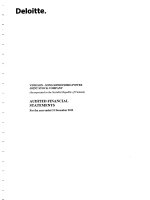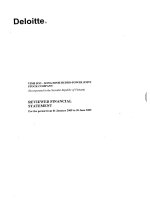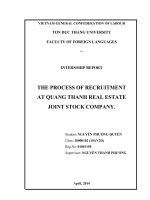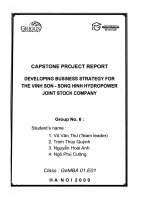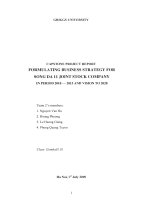developing strategy of danhim ham thuan dami hydro power joint stock company after equitizing 2010 2015 pdf
Bạn đang xem bản rút gọn của tài liệu. Xem và tải ngay bản đầy đủ của tài liệu tại đây (1.81 MB, 125 trang )
2011
GLOBAL ADVANCED MBA PROGRAM GaMBA.D0109
CAPSTONE PROJECT REPORT
DEVELOPING STRATEGY OF DANHIM – HAM
THUAN – DAMI HYDRO POWER JOINT STOCK
COMPANY AFTER EQUITIZING (2010-2015)
Class: GEMBA01.E02
Group 6:
1. Pham Thi Hong Ha
2. Vu Thi Hao
Group 06
3. Nguyen Thien
4. Vu Duy Hieu
5. Ho Dao Phuoc Nguyen
ACKNOWLEDGEMENT
From the depth of our heart, we would like to give all best words to thank all staffs
and Professor of Educational Technology & Career Development - Vietnamese
National University, Hanoi, who have a great enthusiasm, knowledge and guidance
to help us finish this capstone project.
To achieve the result today, we never forget to present our thankfulness to The
Management Board of Da Nhim - Ham Thuan - Đa Mi Hydro Company, who give
us several worth advises during establishing DHD’s developing strategy.
For financial support, we thank Electricity of Vietnam (EVN). The scholarship from
EVN has made our dream of study master program to be fulfilled. Moreover, EVN
has given us an opportunity to study in an International environment which gives us
much more confidence for our work in future.
Finally, we are grateful our family for all material and mental supports that they
have given us during the time of studying.
i
TABLE OF CONTENTS
Page
Additional cover page
Acknowledgements ............................................................................................. i
Table of contents ................................................................................................ ii
List of Abbreviations ...........................................................................................v
List of tables ...................................................................................................... vi
List of figures, graphs and diagrams ................................................................ vii
INTRODUCTION ...............................................................................................1
Chapter 1: CORPORATION STRATEGY THEORY .............................................5
1.1 Overview of strategy and strategic management ..........................................5
1.1.1 What is strategy? ...................................................................................5
1.1.2 Strategic management determination ....................................................5
1.1.3 Strategy at Different Levels of a Business ............................................6
1.1.4 The components of strategic management ............................................6
1.2 Benefits and limitation of strategic development to corporate....................17
1.2.1 Benefits ...............................................................................................17
1.2.2 Limitations of strategic management ..................................................18
1.3 Strategy planning process ............................................................................19
1.3.1 Strategy formulation ...........................................................................19
1.3.2 Strategic implementation ....................................................................20
1.3.3 Strategic evaluation .............................................................................20
1.3.4 Strategic management model ..............................................................21
1.4 The strategy hierarchy .................................................................................22
1.4.1 Corporate strategy ...............................................................................22
1.4.2 Business unit level strategy .................................................................24
1.4.3 The functional strategy ......................................................................26
ii
1.5 The tools for strategies formation and selection ........................................31
1.5.1 External factor evaluation (EFE) ........................................................31
1.5.2 Internal factor evaluation (IFE) ..........................................................31
Chapter 2: ACTUAL SITUATION ANALYSIS OF DA NHIM – HAM
THUAN – DA MI HYDRO POWER COMPANY .............................33
2.1 Da Nhim – Ham Thuan – Da Mi hydro power company introductions ......33
2.1.1 Da Nhim hydropower plant ................................................................33
2.1.2 Song Pha hydropower plant ................................................................34
2.1.3 Ham Thuan hydropower plant ............................................................34
2.1.4 Da Mi hydropower plant .....................................................................35
2.1.5 Business fields.....................................................................................36
2.2 External environment analysis ....................................................................37
2.2.1 Macro environment analysis ...............................................................37
2.2.2 Present situation of Vietnam electricity market ..................................41
2.2.3 Electricity competition analysis ..........................................................42
2.2.4 External factors evaluation matrix (EFE) ...........................................55
2.2.5 Determine opportunities and threats ...................................................56
2.3 Internal enviroment analysis of DHD..........................................................58
2.3.1 Results of the manufacturing business of the company over
the years ..............................................................................................58
2.3.2 Resources and potential ability analysis, identify core values..........60
2.3.3 Identify company value chain .............................................................64
2.3.4 Internal factor evaluation matrix .........................................................66
2.3.5 Determine strengths and weaks of the company ................................67
2.4 Customer survey about quality of electricity supply ...................................70
2.4.1 Survey target .......................................................................................70
2.4.2 Survey design ......................................................................................70
2.4.3 Qualititive study ..................................................................................73
iii
2.4.4 Quantitative study ...............................................................................73
2.4.5 Study results ........................................................................................75
2.5 Equitization plan of the Company .........................................................86
Chapter 3: DEVELOPING STRATEGY OF DANHIM – HAM THUAN – DAMI
HYDRO POWER JOINT STOCK COMPANY AFTER EQUITIZING
(2010-2015) ..........................................................................................90
3.1 Define vision, mission and objectives of DHD ...........................................90
3.1.1 DHD’s slogan: DHD Lighting Highland ............................................90
3.1.2 DHD’s view ........................................................................................90
3.1.3 DHD’s mission ....................................................................................90
3.1.4 Targets of DHD ...................................................................................90
3.2 Build up developing strategy of Danhim – Ham Thuan – Dami
hydro power Joint Stock Company after equitizing (2010-2015) ...............91
3.2.1 Electricity production strategy ............................................................91
3.2.2 Service products: provide technical services by Da Nhim
technical service center .................................................................... 102
Chapter 4: CONCLUSION .................................................................................. 107
REFERENCES
APPENDICES
iv
LIST OF ABBREVIATIONS
A0
National dispatching Center
BOT
Build- Operate- Tranfer
DCS
Distributed control system
DHD
Da Nhim-Ham Thuan-Da Mi Hydro Power joint stock
Company
EVN
Vietnam Electricity
IPP
Independent Power plan
JPY
Japanese Yen
WTO
World Trade Organization
ODA
Official Development Aid
Pc
Price in power purchase contract
Qc
Quantity in power purchase contract
SPSS
Statistical Package for the Social Sciences
v
LIST OF TABLES
Tables
2.1
Title
Economy development and power consumption createria in 16
Page
38
nations in 2020 and assumption for Vietnam in 2020 from EVN
2.2
Electric generation capacity of EVN plants and outside EVN
plants in 2008
45
2.3
Competitors in competitive electricity market
49
2.4
External factors evaluation Matrix (EFE)
55
2.5
Business results from 2006 to 2009
58
2.6
Structure of qualification in the company
62
2.7
2.8
Internal factor evaluation matrix
Summary the SWOT matrix and competitive strategies
66
69
2.9
The number of samples
75
2.10
Sample survey characteristics
76
2.11
Verificating reliability Cronbach's alpha results
77
2.12
Descriptive statisticsthe importance of the company to the criteria
for the assessment of experts in the industry
78
2.13
Descriptive statistics the levels of satisfy criteria of the company
through the evaluation of experts in the industry
79
2.14
Factors analysis results
82
2.15
Financial indexs forcase for 2010-2015
86
3.1
Available cash flow
100
3.2
The potential customers
103
3.3
Expected revenue and cost
106
vi
LIST OF FIGURES, GRAPHS AND DIAGRAMS
Figure
1.1
1.2
1.3
1.4
2.1
2.2
2.3
2.4
2.5
2.6
Title
Strategic management processes
PEST analysis
Five competitive forces model
SWOT analysis model
Da Nhim hydro power plant
Song Pha hydropower plant
Ham Thuan hydro power plant
Da Mi hydro power plant
Five competitive forces in electricity sector
Value chain of company
Page
6
7
10
15
33
34
35
35
55
64
Graph
2.1
Market share in 2008 and 2015
46
2.2
Structure of power system in 2008 and 2015
47
3.1
Graph of loading and mobilizing in rainy season
95
3.2
Graph of loading and mobilizing in dry season
96
3.3
Rule diagram to determine market price
98
1.1
The processes and activities in strategic management
19
1.2
Comprehensive strategic management model
21
2.1
Research process
72
2.2
Expectation frame according to descriptive statistics assessment
81
Diagram
vii
INTRODUCTION
1. General context
According to national electricity network development strategy period 2006-2015
considering to 2005 (Electricity plans VI) which was approved by Prime minister’s
decision No 110/2007/QĐ-TTg on 18/7/2007:
Loading forecast:
Adapt to economical and social development demand of national wide with GDP
increases at about from 8.5 to 9% in 2006-2010 period and more. According result
of electricity forecast, electricity using demand will increase at rate nearly
17%/year (basic plan) and about 20%/year (advanced plan) in 2006-2015. In these
plans, advanced plan is considered as operation plan which prepare for 22% of
development incase economic increase suddenly.
Target of electricity development
The development of electricity has to adapt to load demand above. Ensure to fulfill
execute project process of building hydro power plants with such benefits as: flood
defense, water supply, electricity production, develop thermal electricity from gas.
Encourage to build thermal from coal, invest in small capacity hydro power plant, new
energy and recycle energy for remote areas such as urban, mountain and boundary
area.
Exchange energy with neighbor countries to ensure national power source for stable
development.
Above information show that demand of using electricity in Vietnam has grown
continuously along to the development of society. The supply electricity ability of
EVN still has some limitation due to shortage of source, investment capital,
shortage of spare source and shortage of electricity at rush hour. As a result, EVN
has to apply policy to cut power in shift at most of area leading to negative affect
significantly to social development. The main reason of this situation is the tardy
Page 1
most of new power projects which lead to unequal status between supply and
demand in electricity.
Therefore, the urgent duty of Vietnam is speeding up building power sources not
only for high capacity but also medium and small capacity power plants in styles
IPP and BOT. Furthermore, several companies outside EVN also have right to
invest in electricity production such as hydro power and wind power which can help
EVN adapt to load demand. This also opens opportunities for companies which
supply technical services for small scale hydro power plants in the region.
When the competition electricity market is put into operation, electricity generation
companies have to consider bidding the reasonable price per kWh to achieve
highest profit.
2. The necessary of this topic
Vietnam has become a member of WTO, and Vietnam’s economic is in stage of
integrating to the World economic. Enterprises from Vietnam are facing to not only
opportunities but also challenges which affect to their remaining and development.
Therefore, each company has to build a development strategy which based on its
competitive advantage. These advantages will contribute to perform competitive
advantage of the nation.
The difficult in economic today give negative affect to all fields in society including
electricity branch. However, electricity branch is suffered less than other fields due
to its monopoly position.
Due to shortage of electricity in Vietnam, Da Nhim – Ham Thuan – Da Mi HPP still
works effectively with stable of output consumption. However, in order to open
business ability and to ensure stable development, a business strategy to obtain the
best profit in future is necessary. This also is a reason that we choose this topic for
our research project.
3. Research target
Determine strengthen and weakness of DHD to research the vital ability which
causes priority of the company in comparison to others.
Page 2
Determine opportunities, challenges in present and future to establish the best
appropriated strategy.
Building a development strategy for DHD in 2010-2015 periods.
Solutions for researching works focus on two main problems:
Bidding the best price on competition electricity market
Open wide and improve quality of technical services for power plants in the
region.
4. Scope of research
The project gives a general view about process of establishing development strategy
of DHD after equitizing. Input data for researching is based on real situation
combine with forecast result from 2010 to 2015.
Strategy is divided into several stages. Scope of this project will focus on the first
stage of building business strategy for DHD. This project will establish business
levels and solutions to make this strategy to be fulfilled.
5. Methodology of research
Data source
Data source is collected from financial report, annually report, documentations from
EVN, electrical magazines and information on website of EVN.
Interview management board of DHD about view point, development strategy of
DHD.
Collect information via email, and other media means to evaluate quality of
electricity supplying of DHD.
Data processing
Using SPSS program to process data, analyze and evaluate result.
Analyzing business environment of electric industry by “Five Competition Forces”
method of Michael Porter.
Analyzing SWOT of DHD
Analyzing value chain of DHD
And other methods.
Page 3
6. Structure of the research project includes:
Introduction
Chapter 1: Corporation strategy theory
Chapter 2: Analysis real situation of DHD
Chapter 3: Building development strategy of DHD after equitizing in 2010-215
period
Chapter 4: Conclusion
Page 4
CHAPTER 1: CORPORATION STRATEGY THEORY
1.1. Overview of strategy and strategic management:
1.1.1 What is strategy?
Strategy is the direction and scope of an organisation over the long-term: which
achieves advantage for the organisation through its configuration of resources
within a challenging environment, to meet the needs of markets and to fulfil
stakeholder expectations.
In other words, strategy is about:
Get business targets in long-term (business and social reposibilities)
sustainably.
Which markets should a business compete in and what kinds of activities are
involved in such markets?
How can the business perform better than the competition in those markets?
What resources (human resources, skills, assets, finance, technical
competence…) are required in order to be able to compete?
What external, environmental factors affect the businesses' ability to
compete:
environment,
competition,
polictics,
resources,…
risks
management plans?
What are the values and expectations of those who have power in and around
the business?
1.1.2 Strategic management determination:
Strategic management is a science and art of strategy to provide overall
direction and goals to the enterprise, implement, and execute the short-term
and long-term plan base on existing resources to enable the organization to
achieve its long-term objectives.
Concerning to process, strategic management is a level of managerial
activity under specifying the organization's mission, vision and objectives,
drafting a strategy, implementing that strategy and adapting the strategy to
environment towards objectives.
Page 5
1.1.3 Strategy at Different Levels of a Business:
Strategies exist at several levels in any organisation - ranging from the overall
business through to individuals working in it.
Corporate Strategy - is concerned with the overall purpose and scope of the
business to meet stakeholder expectations. This is a crucial level since it is heavily
influenced by investors in the business and acts to guide strategic decision-making
throughout the business. Corporate strategy is often stated explicitly in a "mission
statement".
Business Unit Strategy - is concerned more with how a business competes
successfully in a particular market. It concerns strategic decisions about choice of
products, meeting needs of customers, gaining advantage over competitors,
exploiting or creating new opportunities etc.
Operational Strategy - is concerned with how each part of the business is organised
to deliver the corporate and business-unit level strategic direction. Operational
strategy therefore focuses on issues of resources, processes, people etc.
1.1.4 The components of strategic management:
In practice, a thorough strategic management process has three main components,
shown in the figure below:
Figure 1.1 Strategic management processes
Page 6
1.1.4.1 Strategic Analysis
This is all about the analysing the strength of businesses' position and understanding
the important external factors that may influence that position. The process of
Strategic Analysis can be assisted by a number of tools, including:
a. PEST Analysis - a technique for understanding the "environment" in which a
business operates
PEST is used to research the impact of factors in macro-environment. The factors
are:
Figure 1.2 PEST analysis
These are four factors what affect directly to many economic sectors, they are
outside business and economic sector, which have influence upon the business and
economic sector as a objective factors. Base on the influences, business will give
the adaptive policies and operational activities.
Political factors: When doing business in an administrative unit, they must obey
the local legistration in that area.
Political stability: we will consider the stability of legistration in political
conflict, diplomacy. Which setups has high stablility will contain the good
condition for operational activities and vice versa, which setups in unstable
condition will take adverse effect to business in its area.
Taxation - tax rates and incentives: export duty, import duty, consumption
tax, income tax… will affect to business revenues, profit.
Page 7
The related laws: investment law, business law, labor law, antitrust law,
antidumping law.
Policy: the policies form government will facilitate the business or hamper
business. Such as trade regulations, economic sector development, economy
development
policies,
competitive
regulations,
customer
protection
regulations…
Economic Factors: business need to consider the state of a trading economy in the
short and long-terms and the state intervention into economy.
Status of economy: any economy has their own cycle, each period of
economic cycle, business must give the most suitable decision for
themselves.
The factors affect to economy: interest rates, inflation rates.
Governmental economic policies: Wage legislation-minimum wage and
overtime, economic development strategies of government, preferential
system, government grant…
The business outlook in future: growth rate, GDP development, GDP per
investment rate…
Sociocultural Factors: The social and cultural influences on business vary from
country to country, and they are the customers’ characters in that area.
Culture values are the values that build up the society, promote the
development of society. So that the social and cultural factors are often
protected effectively and strictly; especially for cultural spirituality. We also
cannot deny the cultural interference into vary of countries. The interference
will change the psychographics, life style and create the prospect of good
business to economic sectors.
Besides culture, social features is also need to consider when researching the
market, social features will devide the society into different customer groups,
each group has the different characters, psychology, income…
Page 8
Technological Factors: The world is still living in technological evolution; the
mass of new technoloty has been borned and intergrated into products, services.
Rate of technological development, period of technology and rate of
technological backward: if in the past, the tech-firms must spend a long time
to double the speed of microprocessor, at present, the needed period is about
2-4 years.
Influences of IT, Internet into business.
Besides above considered factors, globalization is a macro factor affect to economic
activities that the business must consider in market reseaches.
Economic intergration factors
Globalization has created a competitive pressure; the competitors are from
all over the world. Affiliation process will make a change in business to
adapt the comperative advantage, division of labour in area and over the
world.
The importance is after affiliation complete, the barrie to trade will be
remove gradually, the coporations have a chance to trade with partners at
remote geographical areas, the domestic market will be upgrade to global
market.
b. Five Forces Analysis – is a tool to define the competitive forces that shape the
industry or market.
The first competitive force: Bargaining Power of Suppliers
The number and the scale of suppliers: the number of suppliers decides the
competitive force, bargaining power to industry, and over business. If the
market is dominated by a few large suppliers, the buying industry often faces
a high pressure on margins from their suppliers.
Alternative the suppliers’ products: in this issue, we consider the alternative
ability of input from suppliers and switching cost.
Information about suppliers: information about suppliers has the big impact
to selecting input suppliers for business.
Page 9
For every industry or business, suppliers always increase the high pressure if
they have big scale, suppliers association and own the rare and valuable
resource.
Figure 1.3 Five competitive forces model
The second competitive force: Bargaining Power of Buyers
Buyers or customers are competitive fore may take influence to all operational
business of industry.
There are two types of buyers: Monopsonistic, quasi-monopsonistic buyers or
distribution buyers both of types are give pressure to business in prices, quality of
goods, accompanied services and they rule the competition in industry via deciding
the purchase price.
Like bargaining power of suppliers, we consider the impact of competitive force to
industry from buyers: scale, important role, switching costs, information about
customers.
The third competitive force: Threat of New Entrants
Page 10
According to Micheal-Porter, the new entrants are the business, who are not in
market but they have the influences in future. The new entrants are many or just
some, high competitive level or not are dependent on the below:
The attraction of industry: this issue shows as ROI, number of customers, the
existing players.
The barriers to entry an industry: the elements make the entry process
become more expensive and complex.
Capitality, technology.
Trading elements: distribution system, brand loyalty of customers, customer
relationships…
The specialized resources: input resource, certifications, invention, human
resources, government protectionist system.
The fourth competitive force: Threat of Substitutes
Substitutes are the products, services which can sastify approximately
the existing products or services in the industry.
The substitutes of beer, wine are products or services to sastify the similar
demands. Some goods can replace for alcohol beverage: coffee, tea, playing
sport. Via above example, we can see the main competitive force of
substitutes is the performance ability compare with the same purpose
product, additionally, the factors such as prices, quality, culture, politics and
technology are also affect to the threats of alternative products.
The suddenness, unpredictability of substitutes: even inside an industry, with
the development of technology, business can create the substitutes for their
own.
The switching costs: using a solar hot water system can replace a using
electric water heater system, but the user must modify all system and it is
also hard to install, sot the solar hot water system is still not popular.
The fifth competitive force: Competitive Rivalry between Existing Players
Page 11
This force describes the intensity of competition between existing players
(companies) in an industry, creating a competitive force.
Status of industry: demand, development rate, the number of competitors in
market…
Structure of an industry: intensive industry or decentralized industry.
Decentralized industry: is an industry with many businesses
competing together, but not any business can control the rest of
businesses.
Centralized industry: an industry with one or a few business rules the
industry.
Barriers for exit: similarly to the barriers for entry, the barriers for exit are
the factors that make the exiting industry become complexly:
Technological barrier, investment barrier.
Bind to labour
Bind to government, the relative organizations.
Bind to strategy, plan.
Forces from stakeholder
In the book “Strategic Management & Business Policy" by Thomas Thomas L.
Wheelen and J. David Hunger has noted the forces from close relationships. It is
included:
Government
Community
Associations
Creditors, donor
Shareholder
Complementor (a term used to describe businesses that directly sell a product
(or products) or service (or services) that complement the product or service
of another company by adding value to mutual customers)
Page 12
c. SWOT analysis – is a useful method of assessing a business, its resources and its
environment.
SWOT analysis model
SWOT analysis model is a useful tool to realize and to give dicision in all
situations in any business.
SWOT provides a tool for strategy analysis, auditing the overall strategic
position or direction of a business or a business plan.
SWOT analysis is analyzing the external environment factors that business must
face to (opportunities and threats) and also the internal factors (strengths and
weaknesses). It is an important tool what requires a long time, high effort, high
expenditure, good ability in collecting, analyzing and processing the information
effectively.
To do SWOT analysis, people often put the self - questions:
Strengths
What is your strongest business asset?
What are your best working activities?
Which needed resource, ability resource?
What do you offer that makes you stand out from the rest?
The issue must be considered from the vision of yourself and from the others’ look.
Advantages are usually formed when compared to competitors. For example, if all
the competitors offer high quality products, a high quality manufacturing process is
not the advantage, that is the essential to survive on the market.
Weaknesses:
• Anything can be improve?
• The work that you do worst?
• Need to avoid performing?
• Must consider the issue on the basis of inside and outside. Others may see
weaknesses that you do not see by yourself.
Page 13
• Why your competitors can do better than you? At this point, must consider
the real and face with the truth.
Opportunities
Where is a good opportunity?
What trends concern you know?
Opportunities can stem from technological change and not just
international market or even in narrow spaces, from a change in state
policy related to operations field of the company, from the change of
social patterns, population structure or fashion…, from the events in the
region.
The most useful searching is reviewing the advantages of their own and
question whether the advantages may open new opportunities or not.
Threats (risks):
• What obstacles are encountered?
• What the competitors are doing?
• The specific demands of work, products or services are changing or not?
• Changing technology my harm anything with the company or not?
• Is there any problem on overdue debt or cash flow?
• Are there any weaknesses are threatening the company?
Analysis often helps to find out what to do and turn weaknesses into prospects.
Results of the SWOT analysis process must ensure the specification, accuracy,
practice and feasibility for the enterprise, because they will use the results to make
the next steps such as strategies formation, targets strategies and mechanisms to
control specific strategies ..
Page 14
Figure 1.4 SWOT analysis model
d . Value Chain Analysis
Value Chain Analysis describes the activities that take place in a business and
relates them to an analysis of the competitive strength of the business. Influential
work by Michael Porter suggested that the activities of a business could be grouped
under two headings:
(1) Primary Activities - those that are directly concerned with creating and
delivering a product (e.g. component assembly);
(2) Support Activities, which whilst they are not directly involved in production,
may increase effectiveness or efficiency (e.g. human resource management). It is
rare for a business to undertake all primary and support activities.
Value Chain Analysis is one way of identifying which activities are best undertaken
by a business and which are best provided by others ("out sourced").
Linking Value Chain Analysis to Competitive Advantage
Page 15
What activities a business undertakes is directly linked to achieving competitive
advantage. For example, a business which wishes to outperform its competitors
through differentiating itself through higher quality will have to perform its value
chain activities better than the opposition. By contrast, a strategy based on seeking
cost leadership will require a reduction in the costs associated with the value chain
activities, or a reduction in the total amount of resources used.
Primary Activities
Primary value chain activities include:
Primary
Activity
Inbound
logistics
Operations
Outbound
logistics
Marketing
and sales
Service
Description
All those activities concerned with receiving and storing externally
sourced materials
The manufacture of products and services - the way in which
resource inputs (e.g. materials) are converted to outputs (e.g.
products)
All those activities associated with getting finished goods and
services to buyers
Essentially an information activity - informing buyers and
consumers about products and services (benefits, use, price etc.)
All those activities associated with maintaining product performance
after the product has been sold
Support activities include:
Secondary
Description
Activity
Procurement This concerns how resources are acquired for a business (e.g.
sourcing and negotiating with materials suppliers)
Those activities concerned with recruiting, developing, motivating
Human
and rewarding the workforce of a business
Resource
Management
Technology Activities concerned with managing information processing and the
Development development and protection of "knowledge" in a business
Infrastructure Concerned with a wide range of support systems and functions such
as finance, planning, quality control and general senior management
Page 16
Steps in Value Chain Analysis
Value chain analysis can be broken down into a three sequential steps:
(1) Break down a market/organisation into its key activities under each of the major
headings in the model;
(2) Assess the potential for adding value via cost advantage or differentiation, or
identify current activities where a business appears to be at a competitive
disadvantage;
(3) Determine strategies built around focusing on activities where competitive
advantage can be sustained.
1.1.4.2 Strategic Choice
This process involves understanding the nature of stakeholder expectations (the
"ground rules"), identifying strategic options, and then evaluating and selecting
strategic options.
1.1.4.3 Strategy Implementation
Often the hardest part. When a strategy has been analysed and selected, the task is
then to translate it into organisational action.
1.2 Benefits and limitation of strategic development to corporate:
1.2.1 Benefits
The reseaches show that strategic management help the company gaining and
maintaining competitive advantage, anything that the firm does especially well
compared to rival firms.
It allows companies adapt to change in external trends, internal capabilities and
resources effectively, understand the position of company in future and can manage
the development of company.
The most important target of strategy is getting the understanding and the coherence
among managers and staffs. When they understand what company is doing and why
company does that, they often realize that they are a part of company; they become
more coherent to support it. The managers and staffs will have a creative thinking
Page 17
